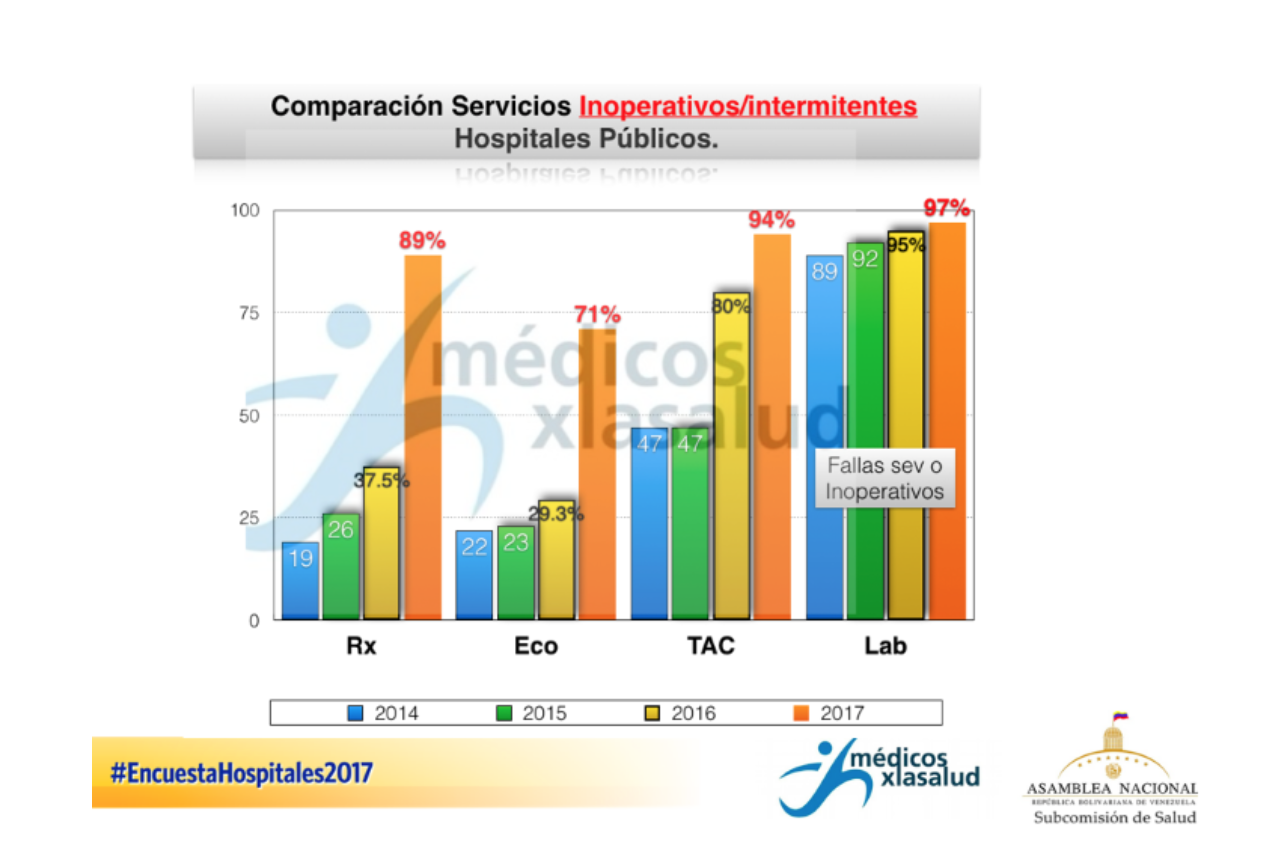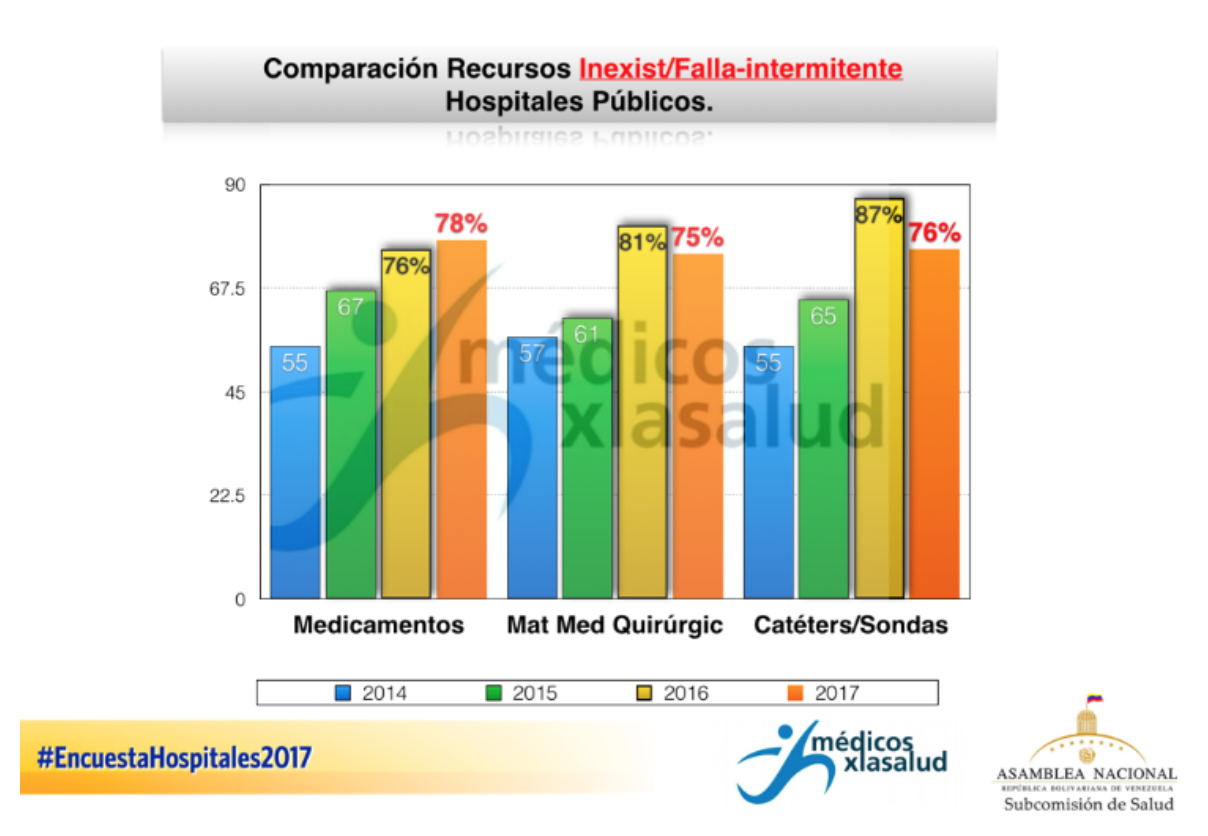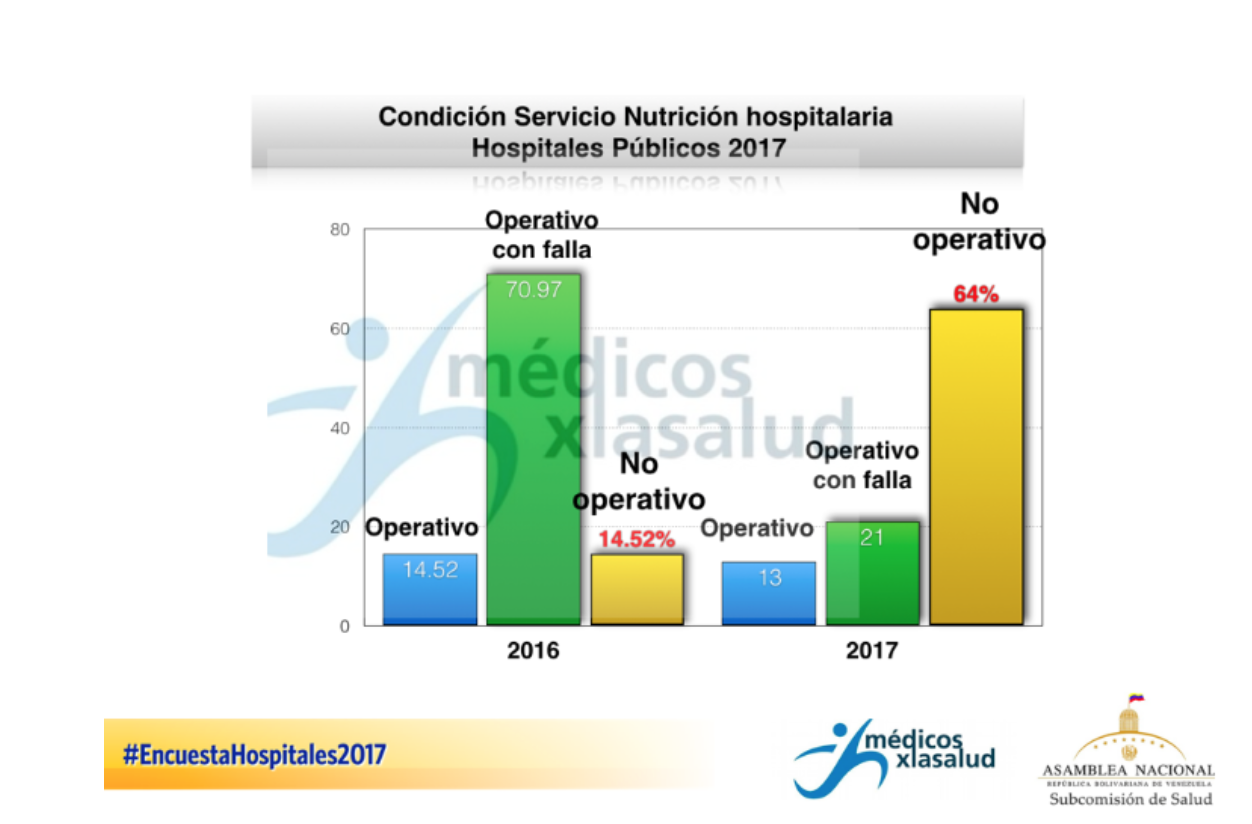A glimpse into the health crisis
You’ve heard the stories about the magnitude of our health crisis . Here's an objective, quantified glimpse of how bad the situation actually is.


By now you’ve probably heard the stories about the magnitude of our health crisis: people dying in hospitals from not getting the drugs they need; operating rooms (OR) closed for not having sutures, masks or even water for the surgeons to wash their hands… In the meantime our Health Minister denies that such a crisis exists while blaming capitalism for causing disease. We knew things were looking grim, but only this week we got an objective, quantified glimpse of how bad the situation actually is.
The National Assembly through its Health Subcommission, along with NGO Medicos por la Salud, issued its fourth National Hospital Poll, a valuable instrument that probed the current status of 92 public hospitals in 42 cities around a country where statistics are a state secret. The pollsters, as expected, had no access to the health centers’ records (there might not be any records left for all we know) so the information is entirely based on the testimony of doctors from several areas which answered a series of questions via electronic questionnaires.
The results are as scary as you could imagine.
The health sector, for years one of the banners of the Bolivarian Revolution, has been hit particularly hard during the last few years. Medicines and medical supplies disappeared along with the petrodollars, not only from pharmacies but also from public and —to a lesser extent— private hospitals.
Keep in mind that this poll doesn’t cover type I (small) hospitals, nor ambulatorios (centers that don’t have inpatient care), in which resources are even harder to find than in bigger hospitals, where the media usually focuses. So, as bad as the numbers are, they might be even worse.
Diagnostic Services
Every “big” hospital (type II-IV) is supposed to treat patients with diseases too complex to be dealt with in the smaller ones. In order to do that, first they must have the means required to confirm or discard the patient’s diagnosis: from relatively high-tech machines like those used for computer axial tomography (CAT or TAC for its spanish acronym) or magnetic resonance images (MRI) to much simpler methods like x-ray, echosonography or even a simple blood test. These areas showed an alarming deterioration over the last year.
 As you can see in the graphic above, almost all hospitals have had problems keeping these services operational. It has been like that for several years, but the degree of deterioration seen lately is simply stunning. Broken or intermittently-working x-ray or echography machines, for example, rocketed from 37,5% and 29,3 to 89% and 71%, respectively, in 2017. This is particularly worrying since these tests, though simple and relatively inexpensive, are absolutely necessary, not only to begin a certain treatment, but also to keep an adequate routine control of healthy patients.
As you can see in the graphic above, almost all hospitals have had problems keeping these services operational. It has been like that for several years, but the degree of deterioration seen lately is simply stunning. Broken or intermittently-working x-ray or echography machines, for example, rocketed from 37,5% and 29,3 to 89% and 71%, respectively, in 2017. This is particularly worrying since these tests, though simple and relatively inexpensive, are absolutely necessary, not only to begin a certain treatment, but also to keep an adequate routine control of healthy patients.
To put things in perspective, while I was attending the trauma and orthopedics service at Merida’s Hospital, we could order up to 30 x-rays in a single day, and we were only one of five different teams. More expensive tests like a CAT-scan have been halted for much longer; in my particular case, I’ve never seen a single tomography made at my hospital during the 6 years I’ve been in med school, even though the required machines are in there, damaged and forgotten. MRI machines are so scarce in the public sector that they don’t even appear in the poll, so needing one of these usually means kissing good bye most of your monthly wage (130,000 Bs for the simplest type the last time I checked).
The labs aren’t doing any better, with 97% being inoperative or working irregularly. Practically every single patient attending a public hospital will be forced to go to a private lab to get tests as simple as an hematology, also part of every routine examination. And that’s not to mention more complex tests, i.e: those required to detect viral or tumoral antibodies, the costs of which can range from 20,000 to 100,000 BsF, since the required reactives must be bought with black-market dollars.
Drugs and Supplies
This has been the main reason why so many people have asked the government to open an humanitarian channel through which the so much needed supplies could quickly get to the country.
Antibiotics, analgesics, antihypertensives, sutures, gloves, masks, catheters… It doesn’t matter, they are all hard to find in over 75% of public hospitals; and so, in most cases, patients must buy pretty much everything they need in order to be treated. If they can’t find it by themselves or simply don’t have the money, they will remain sick, and possibly die. I’ve seen it myself: Last week I had to witness three patients deteriorate to the brink of death because the antibiotic required to treat the multi-resistant bacteria causing them pneumonia had disappeared from every hospital in the state. It’s a high-cost drug, directly imported and distributed by the government, which means it isn’t even sold at regular pharmacies.
Although the poll affirms that shortages of supplies have improved slightly since last year, earlier this week, my local hospital Directorate issued an order forbidding medical students to use masks, gloves and other disposable materials because they had become extremely scarce; the order was eventually revoked after an active protest inside the hospital took place. It was the first time in my 23 years of life that I actually got something tangible from a protest (hooray!).
Like pretty much everything else in the country, these items have recently widened the inventories of bachaqueros. If patients need a suture, they shouldn’t waste their time in pharmacies; any of the dozen buhoneros that roam around hospitals will have them for sale, at about 15 times their real cost, of course. But hey, el Venezolano es pana, you know.
You could hardly say healthcare in Venezuela is free, even though physicians won’t charge. Literally: graduate students, residentes de postgrado as they’re known here, do most of the hard work in hospitals. From running the emergency area, to doing most of the surgeries, depending on which area they specialize in: internal medicine, surgery, pediatrics, whatevertology… They all have their own tasks and they get paid for them. Actually Venezuela is one of not-that-many countries where graduate students get paid while studying. The problem is that their salary is simply ridiculous: about Bs.30k a month, plus a Bs 68k bonus that can only be used to buy food (not including night-shift bonus). If you add both you have an “integral wage” of about Bs 100k… 4.7 dollars a day at the DICOM exchange rate; only 1.1 at the black-market one. The World Bank’s poverty threshold is currently USD 1.9 per day, in case you are wondering.
Residentes can’t work in private practice while studying, due to their exclusive contract . So that income is the only one they’ll see until they graduate.
As if salaries weren’t bad enough already, in Mérida’s Hospital and several other public health centers around the country, residentes have not been paid a single bolívar since the year began, and the situation might continue until May, to be optimistic. Today, they announced residentes are going on a strike that will basically paralyze the entire hospital (with the exception of emergency areas and surgeries). The Directorate’s response? To offer them CLAP bags to tide them over..
It makes perfect sense. That’s the whole point of those bags anyway: they are instruments of control; so why not use them to try to control uncomfortable situations like a hospital strike?
Food and Nutrition
Speaking of food, this is a particularly scary point. Sick people not only need to eat, they must have special diets, usually vital for their full recovery.
 In a country now famous for not having any food, special diets are simply impossible for any institution to do, but the fact that up to 64% of hospitals nation-wide don’t have active clinical nutrition services is extremely alarming, especially when compared to the 14.52% without those programs that were reported last year. In addition, with no signs of improvement in the food distribution chain, it’s clear that the 21% still working with failures will likely shut down completely sooner rather than later.
In a country now famous for not having any food, special diets are simply impossible for any institution to do, but the fact that up to 64% of hospitals nation-wide don’t have active clinical nutrition services is extremely alarming, especially when compared to the 14.52% without those programs that were reported last year. In addition, with no signs of improvement in the food distribution chain, it’s clear that the 21% still working with failures will likely shut down completely sooner rather than later.
Patients aren’t the only ones affected by the food crisis. Walk around the hospital wards of any public hospital in the country and you’ll find their relatives, some of whom themselves haven’t eaten more than crackers in days, taking care of them. It’s all they can afford. In the case of Mérida, where the hospital receives people from three different states, the situation is often much more dramatic.
Babies don’t escape this reality, as the poll also indicates that 64% of hospitals lack infant formulas. This isn’t such a big problem if babies are being taken care of by mothers who don’t have any contraindication to lactate; but it’s quite bad when the mothers are taking drugs that can be secreted into milk, or they’re ill with infectious diseases that can be transmitted by mother’s milk, like HIV.
The poll also reported that only 51% of all operating rooms in the country remain active. Reasons for this are widely varied, from broken or contaminated air conditioners to water cuts, floods or lack of materials required to operate. These limitations mean that even when working, ORs can only be used to do quite simple surgeries, which means that more complex surgeries are usually done only in private health centers.
These private centers, according to lawmaker José Manuel Olivares (who presented the poll), end up attending up to 55% of the population, but their prices (that already highlighted in Olivares’ unfortunate declarations last week) make them completely unattainable for an enormous part of an impoverished country.
But hey, I guess I shouldn’t complain too much since President Maduro just declared Merida, along with several other states, Territorio 100% Barrio Adentro last week.
Quality health for the pueblo, right?
Caracas Chronicles is 100% reader-supported.
We’ve been able to hang on for 22 years in one of the craziest media landscapes in the world. We’ve seen different media outlets in Venezuela (and abroad) closing shop, something we’re looking to avoid at all costs. Your collaboration goes a long way in helping us weather the storm.
Donate




